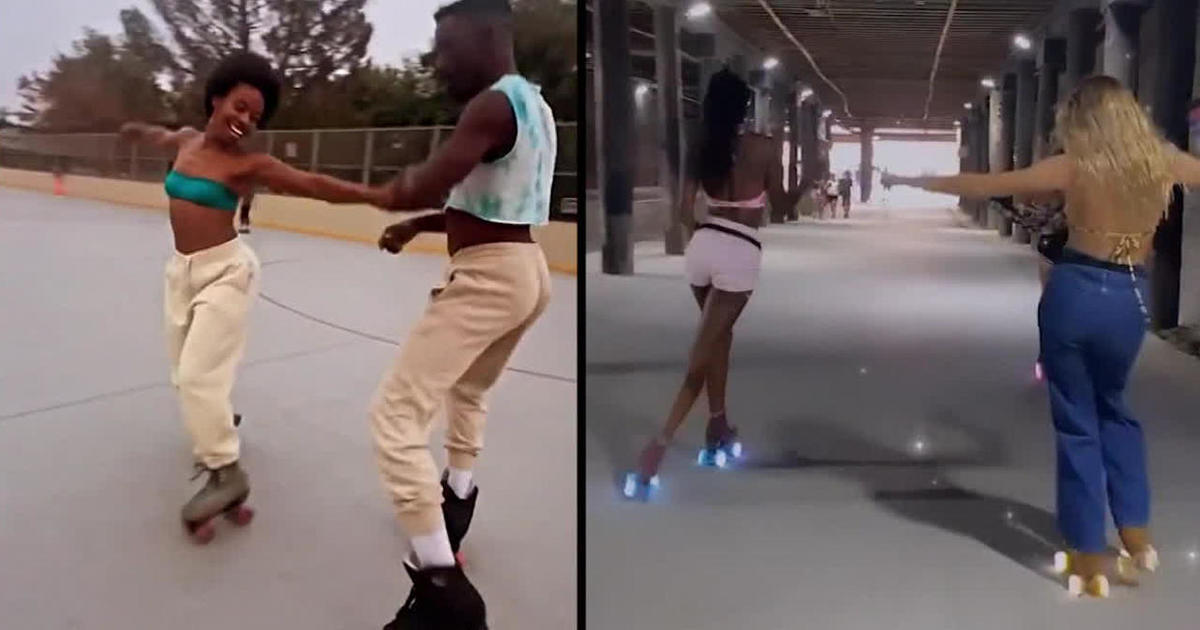For many people, nothing beats a walk in the park – especially on a warm, sunny day. But why stroll, when you can roll? Roller skating, that four-wheel throwback, is staging a surprising comeback. From a crowd in Queens, New York to the Southern California coast, enthusiasts are going old-school, and loving every minute of it.
“It feels, like, ultimate liberation honestly, it’s like flying,” said Sarah Haywood, a 34-year-old from San Diego. She hadn’t put on a pair of skates in 18 years, but that all changed in 2020.
Sarah Haywood, of San Diego, has returned to her love of roller skating.
Correspondent Nancy Giles asked, “Was it the pandemic? Was that kind of the situation make you want to connect with your inner child again?”
“I just realized, ‘Okay, if i’m gonna be home for the next 60, 90, 120 days, what can I do that’s gonna really serve my soul?'” Haywood replied.
She’s not alone. Three-thousand miles away, Tanya Dean, a retired corrections officer, is also gliding to the music.
She described the joy she experiences while roller skating: “It makes you feel like a kid! It brings you back to the time where the world was innocent.”
In New York, Tanya Dean leads a line of roller skating enthusiasts.
CBS News
As far as fads go, skating is no flash in the pan. Charlie Chaplin used it as a prop in his classic “Modern Times” – and fast-forward decades later, when Gene Kelly went from singin’ in the rain to rollin’ in the rink for the 1980 film “Xanadu.”
Fact is, skating stretches back centuries. And that history is on display at the National Museum of Roller Skating in Lincoln, Nebraska.
Peggy Young, a consultant to the museum (“I love skating; I have not done it in recent years, though!”) said the sport began in the Netherlands. “There’s evidence that suggests the first skates were made in the 1700s by the Dutch, wishing to extend their skating season,” she told Giles. “They added wooden spools to the bottom.”
An early Dutch pair of roller skates, at the National Museum of Roller Skating in Lincoln, Nebraska.
CBS News
That was the birth of the inline skate – which has its wheels in a row. But the quad variety caught on thanks to an American inventor.
“James Leonard Plimpton was known as the father of roller skating,” Young said. One of the skates he patented featured wheels that allowed the skater to lean and turn corners. “And that revolutionized the whole industry of roller skating.”
And what an industry it became. There were performing acts and derbies, and rinks by the hundreds.
A few still remain, like Guptill’s Arena in Cohoes, New York – featured in the Guinness Book of World Records as the largest indoor roller skating rink in the world.
Guptill’s Arena.
CBS News
Skip Guptill is the owner of this 64,000-square-foot time capsule. His father turned farmland into the rink that opened on Valentine’s Day, 1951. “My father stood at the front door and turned the key in the door, and there must have been 800 people at the front door to come in!” he remembered.
Crowds used to skate to organ music, but in the 1970s a different sound arrived, as did the disco balls.
Temporarily closed because of COVID-19, Skip Guptill hopes to re-open soon.
Giles asked, “What is it about this rink, you think, that’s kept this going where other rinks have kind of come and gone?”
“It’s family-run,” Guptill replied. “And the nostalgia of coming back here. People remember that their grandmother had a good time, their kids had a good time. and now their grandkids are having a good time. And they never forget that.”
Rink or no rink, people are skating where they can, showing off styles and skills. Tanya Dean holds Zoom classes to clients from around the world.
As for Giles, she used to roller skate, but that was 40 years ago. Now she’s slowly getting back on her feet, with the help of Skip Guptill’s granddaughter, Claire – a very patient coach!
Nancy Giles gets back on wheels.
CBS News
For more info:
- National Museum of Roller Skating, Lincoln, Neb.Follow Sarah Haywood on InstagramGuptill’s Arena, Cohoes, N.Y.Tanya Dean’s Skaterobics
Story produced by Gabriel Falcon. Editor: Carol Ross.
